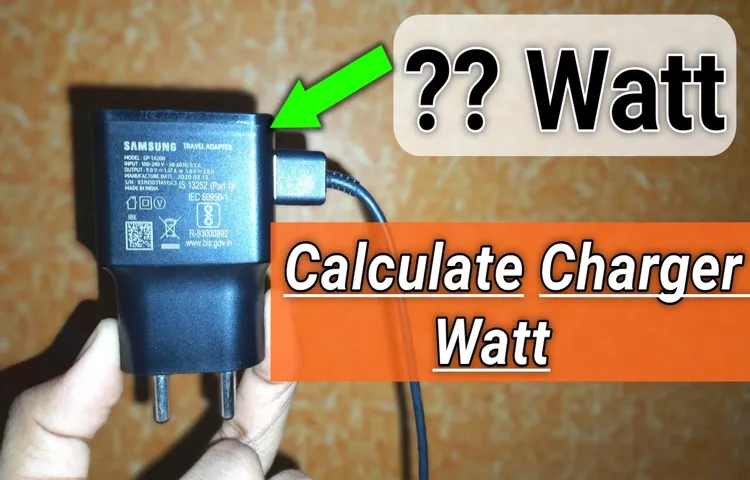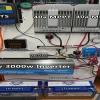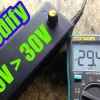Have you ever found yourself in a situation where you need to power electronic devices on the go? Whether you’re camping in the great outdoors or traveling in your RV, having a reliable power source is essential. This is where a watt power inverter comes in handy. But with so many options available on the market, how do you determine which one is the right fit for your needs? Think of a watt power inverter as a portable power station.
It takes the DC power from your vehicle’s battery and converts it into AC power that can be used to charge and operate various devices. It’s like having a portable outlet wherever you go. Determining the watt power inverter you need depends on two main factors: the wattage of the devices you want to power and the peak power requirements of those devices.
For example, if you want to power a laptop that requires 60 watts and a microwave that requires 1000 watts, you would need an inverter that can handle at least 1060 watts. To make things easier, manufacturers provide a continuous power rating and a peak surge power rating for their inverters. The continuous power rating indicates the maximum amount of power the inverter can supply for an extended period, while the peak surge power rating indicates the maximum amount of power the inverter can supply for a short period, usually a few seconds.
When choosing an inverter, it’s important to consider both the continuous power rating and the peak surge power rating. You want to ensure that the inverter can handle the peak power requirements of your devices without overloading or overheating. It’s worth noting that some devices, like refrigerators and air conditioners, have a higher peak power requirement when they start up.
This is known as the starting surge or inrush current. If you plan on powering such devices, make sure to choose an inverter with a higher peak surge power rating to accommodate these power spikes. In addition to power ratings, other factors to consider when choosing a watt power inverter include the number of outlets, the type of outlets (AC or USB), and additional features like overload protection and low voltage shutdown.
So, the next time you find yourself in need of portable power, take into account the wattage of your devices and their peak power requirements. By choosing the right watt power inverter, you can have the peace of mind knowing that you’ll always have a reliable power source wherever you go.
Table of Contents
What is a Power Inverter?
If you’ve ever found yourself in need of power while on the go, a power inverter can be a lifesaver. But how do you know what wattage power inverter you need? The answer depends on what you plan to power with it. For example, if you only need to charge a few small electronic devices like phones or tablets, a 150-watt power inverter should be sufficient.
However, if you want to power larger devices like laptops or even small appliances like a blender or microwave, you’ll need a higher wattage inverter. A good rule of thumb is to choose an inverter that’s rated for at least 20% more power than the total wattage of the devices you plan to use. This will ensure that you have enough power to run everything without overloading the inverter.
So before you hit the road, make sure you have the right power inverter to keep your devices up and running.
Heading Three
power inverter, inverter, electrical appliances, convert DC to AC, car battery, portable power source A power inverter is a device that transforms direct current (DC) into alternating current (AC), enabling you to use electrical appliances that require AC power when you only have access to DC power. It is like a magician that takes power from a car battery or other portable power sources and turns it into electricity that can be used by your phone, laptop, or other devices. It’s like having a universal translator for electricity, allowing you to plug in and power up wherever you are.
So, whether you’re on a camping trip, road trip, or just need a reliable backup power source, a power inverter can be a handy tool to have. With its ability to convert DC to AC, it opens up a world of possibilities, making it easier to stay connected and powered up no matter where you are.

Calculating Your Power Needs
When choosing a power inverter, it’s important to calculate your power needs accurately to ensure you select the right wattage. You don’t want to end up with an inverter that can’t handle your power demands or one that is way overkill. To determine the wattage you need, start by making a list of all the devices you plan to power with the inverter.
Note down their power ratings in watts and add them up. Don’t forget to consider any power surges or peak load requirements of your devices. This will give you a rough estimate of the total wattage required.
Once you have this number, it’s recommended to add a 20-30% buffer to account for any future power needs or efficiency losses. Remember, it’s always better to have a slightly more powerful inverter than one that falls short.
Heading Three
Calculating Your Power Needs
Heading Three
power needs, calculating power needs, determining power needs
Considering the Appliances You Want to Power
When considering what size power inverter you need, it’s important to think about the appliances you want to power. Different appliances have different power requirements, and it’s important to choose an inverter that can handle the load. One way to determine this is by looking at the wattage of each appliance.
For example, a refrigerator may require around 500-800 watts to operate, while a microwave could require around 1000-1500 watts. By adding up the wattage of all the appliances you want to power, you can get an idea of what size inverter you’ll need. It’s also important to consider any potential power surges or bursts in electricity that may occur when certain appliances are turned on or off.
Burstiness can put additional strain on the inverter, so it’s important to choose one that can handle these fluctuations. So, when it comes to choosing the right wattage for your power inverter, it’s all about considering the appliances you want to power and their specific power requirements.
Heading Three
When it comes to choosing a solar power system, one of the first things you need to consider is the appliances you want to power. This is because different appliances have different energy requirements, and you need to ensure that your solar power system is capable of meeting those requirements. For example, if you want to power a refrigerator, you will need a system that can provide a consistent and steady supply of energy.
On the other hand, if you only want to power small electronics like smartphones and laptops, you may be able to get by with a smaller and less expensive solar power system. By taking the time to consider the appliances you want to power, you can ensure that you choose a solar power system that meets your specific needs and helps you make the most of the sun’s energy.”
Heading Three
When it comes to setting up a solar power system for your home, one of the most important factors to consider is the appliances you want to power. This will determine the size and capacity of the solar panels and batteries that you will need. Think about the essential appliances that you use on a daily basis, such as your refrigerator, lights, and electronics.
These are typically the appliances that you will want to prioritize when it comes to solar power. However, you also need to consider the power requirements of each appliance. Some appliances, like air conditioners and washing machines, require a lot more power than others.
So, it’s important to determine the total power consumption of all the appliances you want to power and then choose a solar power system that can handle that load. By considering the appliances you want to power, you can ensure that your solar power system is tailored to meet your specific needs and provide sufficient power for your daily activities.
Choosing the Right Power Inverter
If you’re planning to use a power inverter, one of the first questions you might have is, “How many watt power inverter do I need?” The answer to this question depends on a few factors, including the devices you plan to power and their power requirements. First, you’ll need to know the wattage of the devices you plan to connect to the inverter. This information can usually be found on the device itself or in its user manual.
Once you have gathered this information, you can add up the wattages of all the devices you plan to connect to the inverter. It’s important to note that some devices have a startup power surge, which means that they require more power when they are first turned on. To account for these power surges, it’s recommended to choose an inverter with a higher wattage rating than the total wattage of the devices you plan to power.
By doing this, you can ensure that your power inverter will be able to handle the initial power surges and provide a stable power supply for your devices.
Heading Three
power inverter, choosing the right power inverter
Heading Three
power inverter, choose the right power inverter, inverters for home use, power inverter for dc to ac conversion, selecting the right power inverter Blog Section: Heading Three: Why is Choosing the Right Power Inverter Important? Have you ever wondered how you can power your devices when you’re on a camping trip or during a power outage? That’s where a power inverter comes in handy. Whether you need to charge your phone, run a small appliance, or use your power tools, a power inverter can convert the DC power from your battery into AC power. But with so many options available, how do you choose the right power inverter for your needs? When it comes to selecting the right power inverter, there are a few key factors to consider.
The first thing to think about is the wattage. Different devices require different levels of power, so you’ll need to determine how much wattage you’ll need for the appliances or devices you plan to use. It’s always a good idea to choose an inverter with a higher wattage than you think you’ll need to account for any power surges or future needs.
Next, consider the type of power inverter you need. There are two main types: Modified Sine Wave inverters and Pure Sine Wave inverters. Modified Sine Wave inverters are more affordable but may not be suitable for all devices, especially those with sensitive electronics.
Pure Sine Wave inverters, on the other hand, produce a cleaner and more stable power output, making them ideal for sensitive electronics. Furthermore, think about the size and portability of the inverter. If you plan to use it at home or in your vehicle, a larger inverter may be suitable.
However, if you’re looking for something compact and portable for outdoor use, a smaller inverter will be more convenient. Lastly, don’t forget to consider the quality and brand reputation of the power inverter. Investing in a reliable and reputable brand will ensure that your inverter is durable and long-lasting, providing you with reliable power whenever you need it.
In conclusion, choosing the right power inverter is essential to ensure that you have a reliable and efficient source of power. By considering factors such as wattage, type of inverter, size, and brand reputation, you can find the perfect power inverter for your needs. So, whether you’re going on a camping trip or preparing for a power outage, make sure to choose the right power inverter to keep your devices powered up and running smoothly.
Conclusion
In conclusion, determining the right wattage for your power inverter is crucial to avoid any unexpected power failures or overheating issues. It’s like choosing the perfect shoe size – too small and your feet will feel cramped, too big and you’ll be tripping all over the place. Just like Goldilocks searching for her ideal porridge, you want an inverter that’s just right for your needs, providing enough power to keep your devices running smoothly without wasting excess energy.
So, don’t be left in the dark – calculate your power requirements and find that perfect wattage sweet spot. After all, with the right power inverter, you’ll be powering through any electricity-related challenges in no time. Talk about electricity goals!
FAQs
How do I calculate the wattage of a power inverter that I need?
To calculate the wattage of a power inverter that you need, you should consider the total power consumption of the devices you plan to connect to the inverter. Add up the wattage ratings of all the devices and choose an inverter with a wattage capacity that is equal to or greater than this total.
What factors should I consider when determining the wattage of a power inverter?
Some factors to consider when determining the wattage of a power inverter include the types of devices you plan to connect, their wattage ratings, and whether you will be running them simultaneously or intermittently. It’s also important to consider any potential power surges during startup or heavy load conditions.
Can I safely connect devices with a wattage higher than my power inverter’s rating?
It is not recommended to connect devices with a wattage higher than the rating of your power inverter. Doing so can cause the inverter to overheat or fail, potentially damaging your devices or even causing a fire hazard. It’s best to choose an inverter with a wattage capacity that exceeds the maximum wattage of your devices.
Are there any safety precautions I should take when using a power inverter?
Yes, there are several safety precautions to take when using a power inverter. These include properly grounding the inverter, using appropriate wiring and connectors, protecting the inverter from moisture and heat, and avoiding overloading the inverter. It’s also important to read and follow the manufacturer’s instructions and guidelines.
Can I use a power inverter in my car?
Yes, you can use a power inverter in your car. However, it’s important to ensure that the power inverter is compatible with your car’s electrical system. Check the inverter’s specifications to determine its input voltage range and make sure it matches your car’s voltage. Additionally, be mindful of the inverter’s wattage capacity and the power limitations of your car’s battery.
How long can a power inverter run on a car battery?
The length of time a power inverter can run on a car battery depends on several factors, including the capacity of the battery and the power consumption of the connected devices. To estimate the runtime, divide the battery’s amp-hour rating by the total amp draw of the devices. Keep in mind that running the battery down too low can potentially damage it, so it’s important to monitor the battery’s charge level.
Can I use a power inverter with solar panels?
Yes, you can use a power inverter with solar panels. By connecting the output of a solar panel system to the input of a power inverter, you can convert the DC power generated by the panels into AC power for use with household appliances and devices. Make sure to choose an inverter that is compatible with the voltage and power output of your solar panels.



